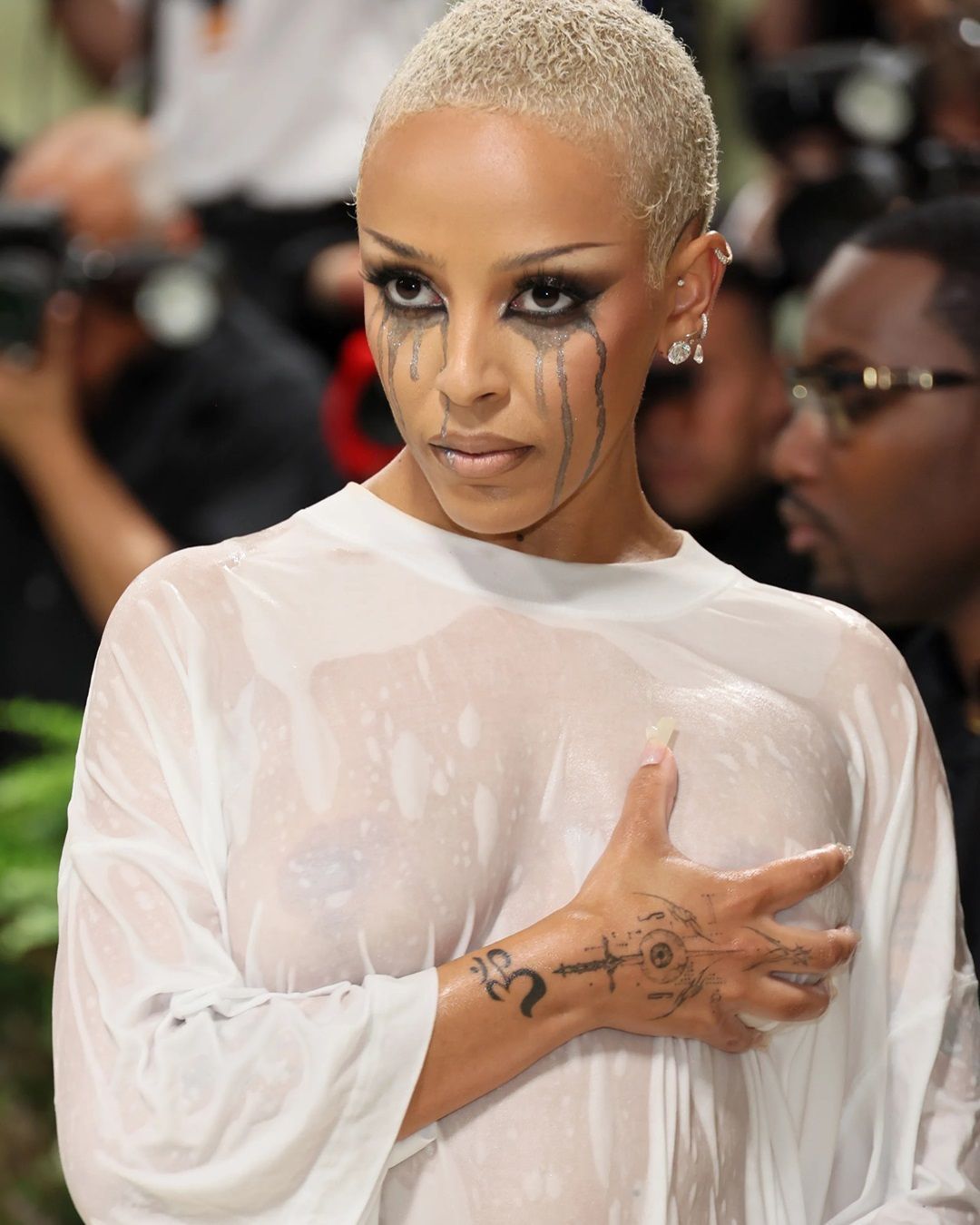
Is fashion obsessed with bodily fluids? Designers have a thing for urine, blood, sweat and tears
Blood, sweat, and tears. These are the latest must-haves, the details that, unexpectedly, make an item special, even desirable. Just think of the "pee-stained" jeans by Jordanluca, with a stain at the crotch simulating incontinence, sold out despite the price being over 600 euros, or the WET Shirt Yeezy x Mowalola, worn by Bianca Censori, Tyla, and Rubi Rose. From the wet look of Doja Cat at the Met Gala to Mike Faist and Josh O'Connor in Challengers, with their bodies glistening to claim the erotic potential of sweat, to Charli XCX, who, to promote her upcoming Sweat Tour, posted a photo of herself with wet panties, it seems pop culture is experiencing a sudden fascination with bodily fluids. Cinema, celebrities, and especially fashion want us soaked, free to flaunt liquids that many of us do everything to hide. Is it time to stop buying antiperspirant deodorants and blushing with embarrassment when a drop of menstrual blood stains our pants?
Sweat is the accessory of the season
They call it olfactophilia, a word that indicates sexual arousal based on someone's natural odor, particularly stimulated by strong ones like sweat, semen, vaginal fluid, and other bodily fluids. A term many do not know, but whose allure, eroticism, and provocative spirit designers intuit, incorporating these elements into their collections. For his FW24 show, Diesel used devoré to represent "the sweat stains that form during parties and raves", while Louis Gabriel Nouchi with his brand LGN has long been offering T-shirts and sweatshirts with stains on the chest, back, and underarms that imitate the sweaty effect of the same garment worn under the scorching sun on a suffocating August day. Bio-designer Alice Potts has gone further, spending recent years transforming bodily fluids into crystals, caps, ballet flats, and sneakers that are true wearable art pieces.
The wet dress: from Galliano to Di Petsa
In the era of Marie Antoinette, during revolutionary France, women would immerse their muslin dresses in water before going out because the wet effect, which made the fabric cling to the body, was considered the height of sensuality. Inspired by this trend ante litteram, John Galliano created the FW86 collection titled The Forgotten Innocents and the SS86 collection Fallen Angels, featuring models in very light and soaked white muslin dresses that revealed their bodies, making them resemble beautiful Greek statues. Who could forget, a few years later in 1998, Alexander McQueen and the finale of Golden Shower (later renamed Untitled), where models dressed in white walked under yellow-lit rain? Since then, the wet effect has made several comebacks on the runway. The contemporary designer who loves this aesthetic the most is Dimitra Petsa, who made her Wetlook Dress—an ethereal gown draped to make it look like water ripples along the body—a cult item, beloved by celebrities like Bella Hadid and FKA twigs.
The "wet" style for Di Petsa is not just fashion
Greek designer Dimitra Petsa seems obsessed with bodily fluids. In 2020, she even wrote a book of poetry titled Wetness, focusing on the relationship between bodily fluids and the sea, discussing blood, sweat, tears, saliva, breast milk, vaginal fluids, semen, and urine, emphasizing that "We should treat our fluids as we treat water, as absolutely natural elements beyond our complete control. If we think about it, being wet is something socially accepted only during sexual intercourse." From tops that mimic breast milk stains to dresses that cling to the body as if drenched in sweat, Di Petsa's creations aim to normalize and celebrate the natural functions of the body, which women have always been conditioned to hide.
Blood, mud, and other sticky substances
Not just sweat. While Diesel and other brands have stuck to the most common bodily fluid, Elena Velez has chosen a substance considered "repellent" and literally made her SS24 collection wallow in mud. Duran Lantink signs the tags of his clothes with his own blood, an organic liquid that, real or mimicked by decorations and dyeing techniques, many designers like Raf Simons for Calvin Klein or Robert Wun have brought to the runway. Prada, on the other hand, made a sort of ectoplasmic slime drip from the ceiling, reminiscent of Slimer from Ghostbusters. Meanwhile, as mentioned earlier, Jordan Bowen and Luca Marchetto chose to imitate urine as a "comment on the fact that we don't actually need more clothes but have an obsessive love affair with things. Consumerism has become an obscene fetish." Highlighting how for many, these fluids are "a representation of power, perversion, and voyeurism."
Provocation or unconventional charm?
For Alice Potts, sweat is "a natural and integral part of the human experience that can foster a deeper appreciation for our body and its capabilities. Whether in moments of passion or exertion, sweat embodies a raw and primal essence that, if embraced with confidence and acceptance, can truly be seen as undeniably seductive." Louis Gabriel Nouchi is attracted to the taboo element. But is openly displaying our excretions really a subversive act? Or is it simply excessive? Would you wear a sweater with fake sweat stains, jeans splattered with urine, or panties simulating female ejaculation?

























































